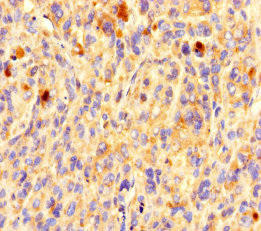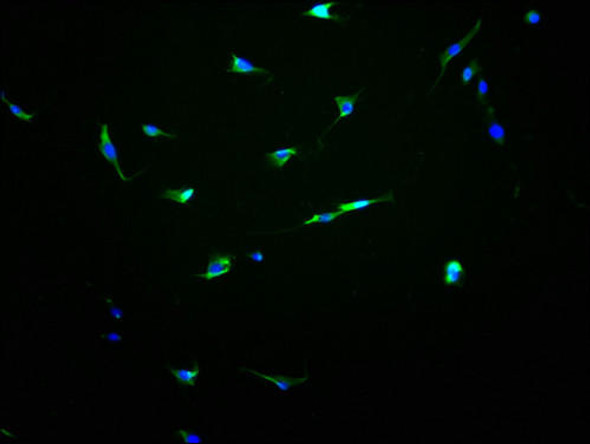Description
| Antibody Name: | OR5L1 Antibody (PACO38822) |
| Antibody SKU: | PACO38822 |
| Size: | 50ug |
| Host Species: | Rabbit |
| Tested Applications: | ELISA, IHC |
| Recommended Dilutions: | ELISA:1:2000-1:10000, IHC:1:20-1:200 |
| Species Reactivity: | Human |
| Immunogen: | Recombinant Human Olfactory receptor 5L1 protein (161-196AA) |
| Form: | Liquid |
| Storage Buffer: | Preservative: 0.03% Proclin 300 Constituents: 50% Glycerol, 0.01M PBS, PH 7.4 |
| Purification Method: | >95%, Protein G purified |
| Clonality: | Polyclonal |
| Isotype: | IgG |
| Conjugate: | Non-conjugated |
 | Immunohistochemistry of paraffin-embedded human melanoma using PACO38822 at dilution of 1:100. |
| Background: | Odorant receptor. |
| Synonyms: | Olfactory receptor 5L1 (OST262) (Olfactory receptor OR11-151), OR5L1 |
| UniProt Protein Function: | OR5L1: Odorant receptor (Potential). Belongs to the G-protein coupled receptor 1 family.Protein type: Receptor, GPCR; GPCR, family 1; Membrane protein, multi-pass; Membrane protein, integralChromosomal Location of Human Ortholog: 11q11Cellular Component: integral to membrane; plasma membraneMolecular Function: G-protein coupled receptor activity; olfactory receptor activityBiological Process: G-protein coupled receptor protein signaling pathway; detection of chemical stimulus involved in sensory perception of smell |
| UniProt Protein Details: | |
| NCBI Summary: | Olfactory receptors interact with odorant molecules in the nose, to initiate a neuronal response that triggers the perception of a smell. The olfactory receptor proteins are members of a large family of G-protein-coupled receptors (GPCR) arising from single coding-exon genes. Olfactory receptors share a 7-transmembrane domain structure with many neurotransmitter and hormone receptors and are responsible for the recognition and G protein-mediated transduction of odorant signals. The olfactory receptor gene family is the largest in the genome. The nomenclature assigned to the olfactory receptor genes and proteins for this organism is independent of other organisms. This olfactory receptor gene is a segregating pseudogene, where some individuals have an allele that encodes a functional olfactory receptor, while other individuals have an allele encoding a protein that is predicted to be non-functional. [provided by RefSeq, Jun 2015] |
| UniProt Code: | Q8NGL2 |
| NCBI GenInfo Identifier: | 38372721 |
| NCBI Gene ID: | 219437 |
| NCBI Accession: | Q8NGL2.1 |
| UniProt Secondary Accession: | Q8NGL2,Q6IFD0, B2RNK6 |
| UniProt Related Accession: | Q8NGL2 |
| Molecular Weight: | 34,559 Da |
| NCBI Full Name: | Olfactory receptor 5L1 |
| NCBI Synonym Full Names: | olfactory receptor, family 5, subfamily L, member 1 (gene/pseudogene) |
| NCBI Official Symbol: | OR5L1 |
| NCBI Official Synonym Symbols: | OST262; OR11-151 |
| NCBI Protein Information: | olfactory receptor 5L1 |
| UniProt Protein Name: | Olfactory receptor 5L1 |
| UniProt Synonym Protein Names: | OST262; Olfactory receptor OR11-151 |
| Protein Family: | |
| UniProt Gene Name: | OR5L1 |
| UniProt Entry Name: | OR5L1_HUMAN |






